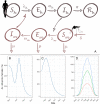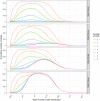Estimating chikungunya virus transmission parameters and vector control effectiveness highlights key factors to mitigate arboviral disease outbreaks
- PMID: 35245304
- PMCID: PMC8896662
- DOI: 10.1371/journal.pntd.0010244
Estimating chikungunya virus transmission parameters and vector control effectiveness highlights key factors to mitigate arboviral disease outbreaks
Abstract
Background: Viruses transmitted by Aedes mosquitoes have greatly expanded their geographic range in recent decades. They are considered emerging public health threats throughout the world, including Europe. Therefore, public health authorities must be prepared by quantifying the potential magnitude of virus transmission and the effectiveness of interventions.
Methodology: We developed a mathematical model with a vector-host structure for chikungunya virus transmission and estimated model parameters from epidemiological data of the two main autochthonous chikungunya virus transmission events that occurred in Southern France, in Montpellier (2014) and in Le Cannet-des-Maures (2017). We then performed simulations of the model using these estimates to forecast the magnitude of the foci of transmission as a function of the response delay and the moment of virus introduction.
Conclusions: The results of the different simulations underline the relative importance of each variable and can be useful to stakeholders when designing context-based intervention strategies. The findings emphasize the importance of, and advocate for early detection of imported cases and timely biological confirmation of autochthonous cases to ensure timely vector control measures, supporting the implementation and the maintenance of sustainable surveillance systems.
Conflict of interest statement
The authors have declared that no competing interests exist.
Figures





References
-
- Franke F, Giron S, Cochet A, Jeannin C, Leparc-Goffart I, de Valk H, et al.. [Autochthonous chikungunya and dengue fever outbreak in Mainland France, 2010–2018]. Bull Epidémiol Hebd. 2019; 374–82.
Publication types
MeSH terms
LinkOut - more resources
Full Text Sources
Medical

